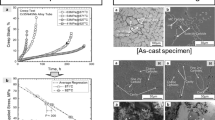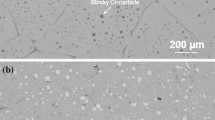Abstract
The carburizing behaviors and mechanisms for Cr35Ni45Nb alloy subjected to different service conditions were studied in a high-temperature vacuum environment. Generally, the carburizing process of an alloy is always accompanied by diffusional heterogeneous reactions regardless of the service condition of the alloy. For a carburized original tube, there is a layered structure at the inner wall of the tube, which is comprised of a M7C3 zone, a M7C3–M23C6 mixed zone, and a M23C6 zone with different morphologies. However, for a 6-year tube (short for a tube serviced for 6 years), the composite oxide layers formed previously act as effective barriers to carbon infiltration. Moreover, the Cr2O3 scale tended to be carbonized to form carbide scale to spall from the surface in a reducing environment, while the SiO2 kept stable all along. Once the oxide layers were removed or carbonized enough, inconceivable internal carburization occurred widely.















Similar content being viewed by others
References
S. Yancheshmeh, S. Seifzadeh Haghighi, M. Gholipour, O. Dehghani, M. Rahimpour, and S. Raeissi: Modeling of ethane pyrolysis process: A study on effects of steam and carbon dioxide on ethylene and hydrogen productions. Chem. Eng. J. 215, 550 (2013).
G. Zhang and B. Evans: Progress of modern pyrolysis furnace technology. Adv. Mater. Phys. Chem. 2, 169 (2013).
H. Grabke and I. Wolf: Carburization and oxidation. Mater. Sci. Eng. 87, 23 (1987).
A. Ul-Hamid, H.M. Tawancy, A-R.I. Mohammed, and N.M. Abbas: Failure analysis of furnace radiant tubes exposed to excessive temperature. Eng. Failure Anal. 13, 1005 (2006).
J. Lee, W. Yang, W. Yoo, and K. Cho: Microstructural and mechanical property changes in HK40 reformer tubes after long term use. Eng. Failure Anal. 16, 1883 (2009).
A.A. Kaya: Microstructure of HK40 alloy after high-temperature service in oxidizing/carburizing environment: II. Carburization and carbide transformations. Mater. Charact. 49, 23 (2002).
T. Ramanarayanan, R. Petkovic, J. Mumford, and A. Ozekcin: Carburization of high chromium alloys. Mater. Corros. 49, 226 (1998).
A. Rahmel, H. Grabke, and W. Steinkusch: Carburization–introductory survey. Mater. Corros. 49, 221 (1998).
R. Petkovic-Luton and T. Ramanarayanan: Mixed-oxidant attack of high-temperature alloys in carbon-and oxygen-containing environments. Oxid. Met. 34, 381 (1990).
S. Ling, T. Ramanarayanan, and R. Petkovic-Luton: Computational modeling of mixed oxidation-carburization processes: Part 1. Oxid. Met. 40, 179 (1993).
D. Mitchell, D. Young, and W. Kleemann: Caburisation of heat-resistant steels. Mater. Corros. 49, 231 (1998).
H. Evans and R. Lobb: Conditions for the initiation of oxide-scale cracking and spallation. Corros. Sci. 24, 209 (1984).
A. Huntz and M. Schütze: Stresses generated during oxidation sequences and high temperature fracture. Mater. High Temp. 12, 151 (1994).
I. Wolf, H. Grabke, and P. Schmidt: Carbon transport through oxide scales on Fe-Cr alloys. Oxid. Met. 29, 289 (1988).
C. Li, Y. Yang, and X. Wu: Analysis of coking and caburizing of HP heat-resistant steel. J. Chin. Soc. Corros. Prot. 22, 289 (2002).
J-W. Snoeck, G. Froment, and M. Fowles: Filamentous carbon formation and gasification: Thermodynamics, driving force, nucleation, and steady-state growth. J. Catal. 169, 240 (1997).
S.H. Khodamorad, D. Haghshenas Fatmehsari, H. Rezaie, and A. Sadeghipour: Analysis of ethylene cracking furnace tubes. Eng. Failure Anal. 21, 1 (2012).
H. Tawancy and N. Abbas: Mechanism of carburization of high-temperature alloys. J. Mater. Sci. 27, 1061 (1992).
V. Tari, A. Najafizadeh, M. Aghaei, and M. Mazloumi: Failure analysis of ethylene cracking tube. J. Fail. Anal. Prev. 9, 316 (2009).
N. Ryzhov, A. Smirnov, R. Fakhurtdinov, L. Mulyakaev, and V. Gromov: Special features of vacuum carburizing of heat-resistant steel in acetylene. Met. Sci. Heat Treat. 46, 230 (2004).
N. Ryzhov, A. Smirnov, and R. Fakhurtdinov: Control of carbon saturation of the diffusion layer in vacuum carburizing of heat-resistant steels. Met. Sci. Heat Treat. 46, 340 (2004).
D. Farkas and K. Ohla: Modeling of diffusion processes during carburization of alloys. Oxid. Met. 19, 99 (1983).
A. Borgenstam, L. Höglund, J. Ågren, and A. Engström: DICTRA, a tool for simulation of diffusional transformations in alloys. J. Phase Equilib. 21, 269 (2000).
A. Kaya, P. Krauklis, and D. Young: Microstructure of HK40 alloy after high temperature service in oxidizing/carburizing environment: I. Oxidation phenomena and propagation of a crack. Mater. Charact. 49, 11 (2002).
ACKNOWLEDGMENTS
The authors are grateful for the financial support and facilities provided by China Special Equipment Inspection and Research Institute and Beijing Institute of Aeronautical Materials, respectively.
Author information
Authors and Affiliations
Corresponding author
Rights and permissions
About this article
Cite this article
Peng, Y., Zhang, M., Xiao, J. et al. Investigations on carburizing mechanisms of Cr35Ni45Nb subjected to different service conditions in a high-temperature vacuum environment. Journal of Materials Research 30, 841–851 (2015). https://doi.org/10.1557/jmr.2015.46
Received:
Accepted:
Published:
Issue Date:
DOI: https://doi.org/10.1557/jmr.2015.46




